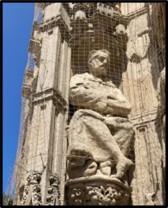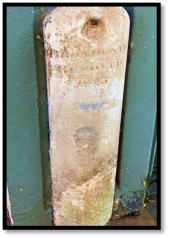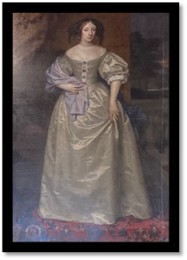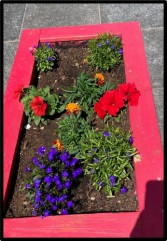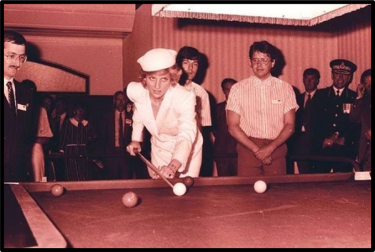
“Royal Visitors to Exeter”
A Guided Walk
Led by Redcoat Guide Mike Richards
on Thursday, 12 June 2025
starting at 2pm from the West Front of the Cathedral
Our group assembled at the West Front of the Cathedral in glorious sunshine. We were a reduced number, owing to the change of date, necessitated by the bad weather on June 13. However, undeterred, we listened as Mike introduced himself and began the tour by pointing out the carving of William the Conqueror on the Cathedral's image screen on the West Front. The current carving is a repair, as the original figure was damaged when someone climbed the screen in the early 19th century. While on the Green, Mike told us about King Alfred in the 9th Century, who drove the Danes away, although they returned in 1003 and again attacked Exeter, burning down the monastery that had been founded by King Athelstan. King Edward the Confessor and his wife Edith arrived in 1050 to install Leofric into his Bishop's throne, in the Saxon Minster (which predated the Cathedral) in 1050.
Before leaving Cathedral Green, we walked to the passage way between The Ivy and Pizza Express (formerly Tinleys). The Broad Gate, once situated here, is marked by a post with a ring. At this point Mike told us the story of a notorious murder which took place in the precincts of the Cathedral. The Bishop, Peter Quinil was at odds with the Dean (John Pycot) who had been fraudulently elected as Dean in the absence of the Bishop. The feud between them came to a head when the Bishop appointed his own candidate (Walter Lechlade) to be Precentor of the Cathedral. Pycot formed an alliance with the Mayor of Exeter and the Guilds, and it was alleged that they instigated the murder of Walter Lechlade in November 1283. In 1285, King Edward I and his wife, Eleanor of Castile, presided over the trials of the accused, twelve of whom were convicted. Five of the secular members of the plot were hung (probably at Northernhay) and the ecclesiastical plotters were handed over to the church authorities for punishment. King Edward subsequently gave permission for the Cathedral authorities to construct a wall round the precinct in 1286. We also observed the Devon county war memorial designed by Edward Lutyens and unveiled by Edward Prince of Wales in 1921.
We then walked to the Guildhall, where Mike had arranged for us to visit, and we were greeted by the Mace Sergeant. It was nice to be
out of the hot sun, as Mike told us about the events of 1497 when Henry VII was pursuing Perkin Warbeck after his unsuccessful siege of Exeter. When Warbeck was captured King Henry
7th took him as prisoner to Exeter in his triumphal procession. Henry stayed in Exeter for a month, lodging at the house of the Cathedral Treasurer. The remaining rebels were paraded each day past
the king's residence, with halters (symbolising nooses) round their necks. This continued daily, until eventually the king addressed them, and he spared the repentant, who threw down their halters
and shouted, God Save the King
. The King presented a sword and his Cap of Maintenance to the Mayor, as a reward for Exeter citizens loyalty to him. These items were carried before the Mayor in
parades, as they still are.
Exeter was also host to Queen Henrietta Maria, wife of Charles I, and she lodged in Bedford House, where she gave birth to their daughter, Henrietta Anne Stuart in 1644. She was baptised in Exeter Cathedral. King Charles visited Exeter in July, and saw his baby daughter for the first and last time. There is a portrait of Princess Henrietta Anne, painted by Peter Lely, in the Guildhall.
In Queen Street we paused by Marks and Spencer — on the roof of which is a fibreglass copy of the original statue of Queen Victoria which had been on the site of the old Waltons. Unfortunately, it was not to be seen as it was shrouded in scaffolding and plastic sheeting! The Queen never actually set foot in Exeter. Once, when her royal train was at St. David's Station, the town band played and the Mayor stood on the platform, but she did not alight.
After leaving Queen Street we passed by St. Stephen's Bow, where King Henry VI, who was riding on a horse, had to dismount and bow, to get through the arch. The route was planned by Bishop Lacy in 1452, and was perhaps designed to humble the unpopular king.
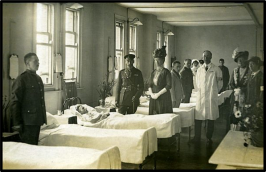 King George V and Queen Mary visiting the soldiers at Bradninch Hall. Image courtesy of Exeter Memories website.
King George V and Queen Mary visiting the soldiers at Bradninch Hall. Image courtesy of Exeter Memories website.
Passing on up Castle Street, we paused by Bradninch Hall, which was the first hall of residence for the University of Exeter. During WWI it was repurposed as a Red Cross Hospital, and the wounded soldiers were visited there by King George V and Queen Mary.
From Castle Street we looked up towards the remains of the fortified Rougemont Castle, built by William the Conqueror in 1068. It was visited by Richard III in 1483, and he commended it highly, both for its strength and beauty of situation.
From here we walked back down towards Princesshay, looking at the plaque commemorating the Blitz during WW2. We stood by the flower box (pictured) in Princesshay, which, Mike told us, is the spot where Princess Elizabeth stood to open the shopping precinct in 1949. The current Princesshay was opened in 2007.
Coming back to Cathedral Green we viewed the remains of the Royal Clarence, burnt down in 2016, and only now beginning the long path to renovation. The Royal Clarence began its existence as a Canon's house, and then an Assembly Room. When it became an hotel, it was named the Cadogan Hotel, before being purchased in 1826 by Sarah Street, who renamed it. The Duchess of Clarence (later Queen Adelaide) wife of the future William IV, stayed there in 1827. Permission was sought, and granted, to rename the hotel the Royal Clarence.
Fascinating fact — Edward the Duke of Kent (father of Queen Victoria) was staying in Sidmouth in 1820, when he caught pneumonia and sadly died. His body was brought to the Royal Clarence, Exeter, and Dr. Patch embalmed the body on the kitchen table! He was offered a knighthood, or 200 guineas as a reward. He took the money! Lord Louis Mountbatten also visited the hotel in 1950.
We then returned to the west front of the Cathedral, where Mike finished the tour by telling us that, when William of Orange landed in Brixham in 1688, he travelled to Exeter, marched into the Cathedral, sat on the Bishop's throne, and announced that he came with peaceful intent. He had been invited by a group of English nobles to replace the unpopular James II, who fled to France.
Other notable visitors to the Cathedral, were George III, who held a levée in the Bishop's Garden in 1789, and George VI who visited after the Blitz. The present King, Charles III, is a great supporter of the Cathedral, and has visited several times.
Finally, Mike asked us to guess who his favourite visiting Royal is! His favourite turned out to be Princess Diana, who came to open the Plaza (now Riverside) Leisure Centre in 1986. She opened the swimming pool, and tried her hand at playing snooker.
Judith Hosking
